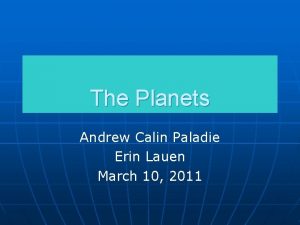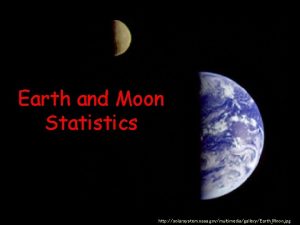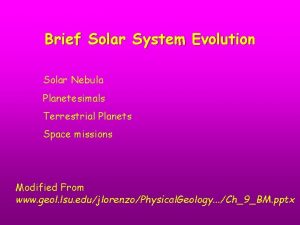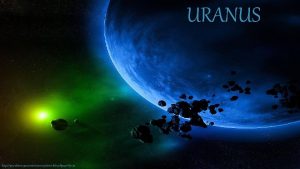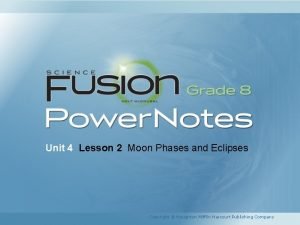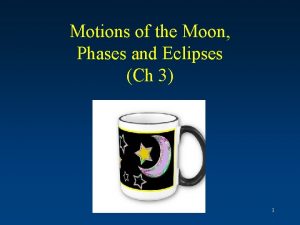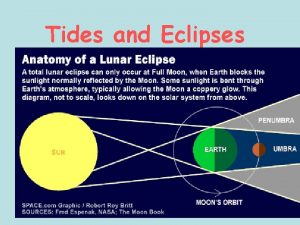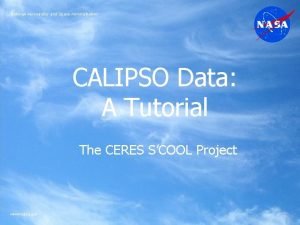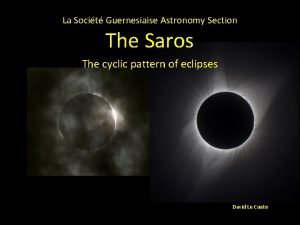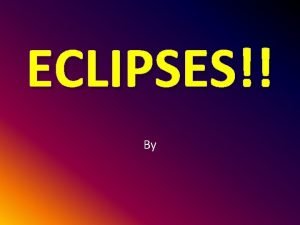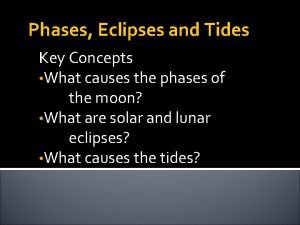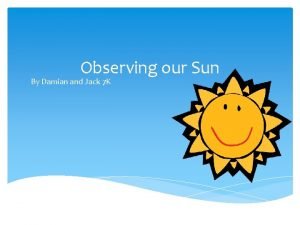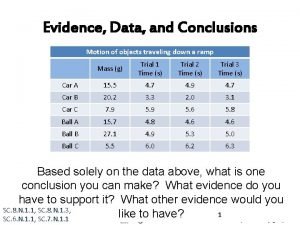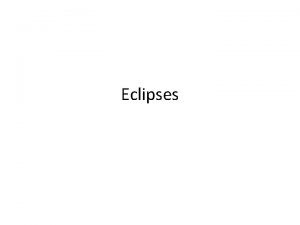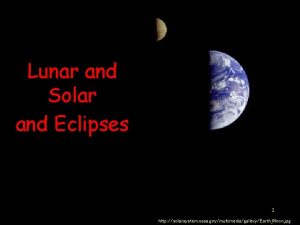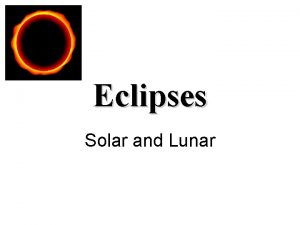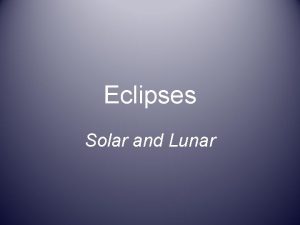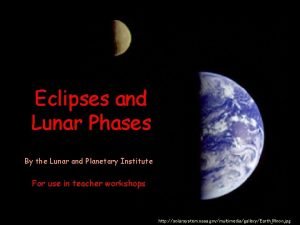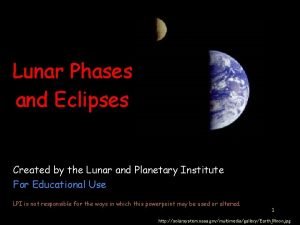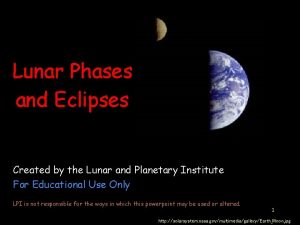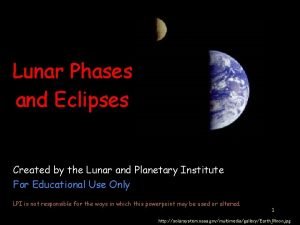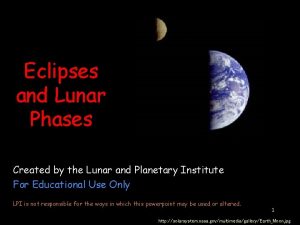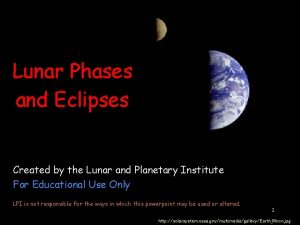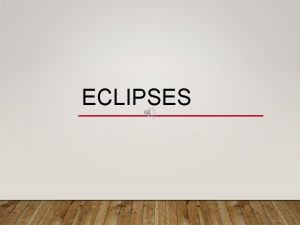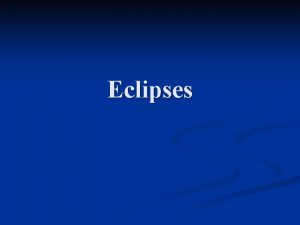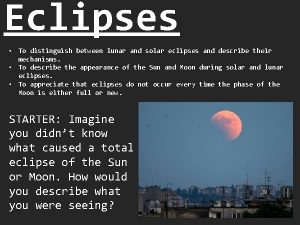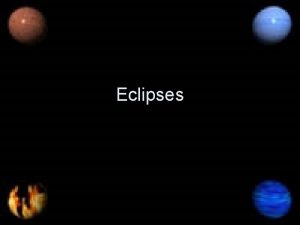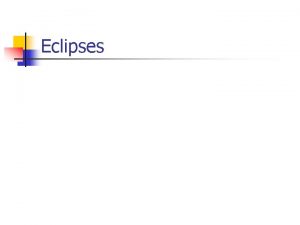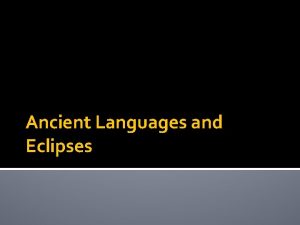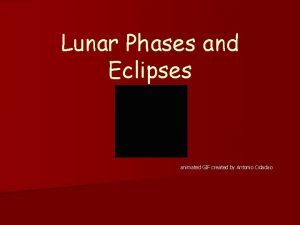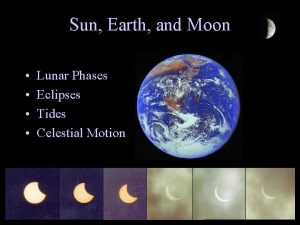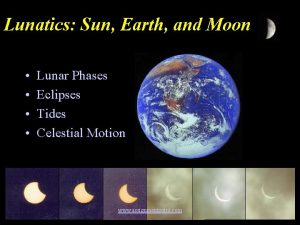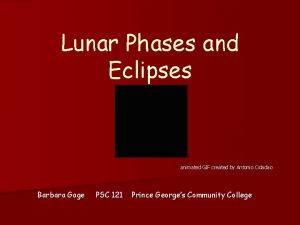Lunar Phases and Eclipses 1 http solarsystem nasa




















- Slides: 20

Lunar Phases and Eclipses 1 http: //solarsystem. nasa. gov/multimedia/gallery/Earth_Moon. jpg

Phases: Observing and Identifying New (couple days) Waxing Crescent (several days) 1 st Quarter Waxing Gibbous (several days) Full Waning Gibbous (several days) 3 rd Quarter Waning Crescent (several days) New http: //www. lpi. usra. edu/education/skytellers/moon_phases/about. shtml 2

Phases--Causes • The Sun shines on the Moon. – When the sunlight reflects off the Moon’s far side, we call it a New Moon – When the sunlight reflects off on the Moon’s near side, we call it a Full Moon – Between New and Full, we see parts of the daytime side of the Moon. 3

4 http: //starchild. gsfc. nasa. gov/docs/Star. Child/questions/question 3. html

5 starchild. gsfc. nasa. gov/docs/Star. Child/questions/phases. html

Eclipses • The Sun and Moon occasionally line up so that we have an eclipse. – These eclipses happen every year – To see a solar eclipse, you need to be on a particular part of the Earth 6

When the Earth’s shadow covers the Moon, we have a lunar eclipse 7

Three types of Lunar Eclipses • Penumbral lunar eclipse—the Moon only passes through the penumbra of Earth’s shadow • Partial lunar eclipse—part of the Moon passes through the umbra of Earth’s shadow • Total lunar eclipse—the entire Moon passes through the umbra of Earth’s shadow • Who on Earth will be able to see a lunar eclipse? Anyone who can see the Moon (anyone who is on the nighttime side of the Earth during the eclipse) 8

Images from Fred Espenak http: //www. mreclipse. com/LEphoto/LEgallery 1. html 9

Why is the Moon red during an eclipse? • The Earth’s atmosphere filters some sunlight and allows it to reach the Moon’s surface • The blue light is removed—scattered down to make a blue sky over those in daytime • Remaining light is red or orange • Some of this remaining light is bent or refracted so that a small fraction of it reaches the Moon • Exact appearance depends on dust and clouds in the Earth’s atmosphere 10

Recent Lunar Eclipses • • • Nov. 28, 2012, Penumbral eclipse Apr. 25, 2013, Partial eclipse (not visible in US) May 25, 2013, Penumbral eclipse Oct. 18, 2013, Penumbral eclipse Apr 15, 2014, TOTAL ECLIPSE –visible here 11

Solar Eclipses • When the Moon’s shadow covers part of the Earth • Only happens at New Moon • Three types: Annular, Partial, and Total 12

Total Solar Eclipse • • Observers in the “umbra” shadow see a total eclipse (safe to view the Sun); can see the corona Those in “penumbra” see a partial eclipse—not safe to look directly at Sun Only lasts a few minutes Path of Totality about 10, 000 miles long, only 100 miles wide 13

Photo of a Total Eclipse 14 http: //sunearthday. nasa. gov/2006/multimedia/gal_008. php

Annular Solar Eclipse • When the Moon is too far to completely cover the Sun—the umbra doesn’t reach the Earth • Sun appears as a donut around the Moon 15

Photos of an Annular Eclipse http: //sunearthday. nasa. gov/2006/multimedia/gal_010. php; photos taken by Fred Espenak 16

Recent/Upcoming Solar Eclipses • May 10, 2013, annular eclipse—not visible in USA • Next Total Solar Eclipse in continental USA—August 21, 2017 17

Tides • The Moon’s gravity tugs on the Earth. – It pulls the most on the part of Earth closest, which raises the atmosphere, the oceans, and even the rocks (a little) – It pulls the least on the part of Earth that’s farthest, which allows the oceans and atmosphere to be further from the Moon (and higher) – The Sun’s gravity does the same thing, but to a lesser extent 18

Tides and the Moon 19

“Cheesy” Moon Jokes 20
 Http://solarsystem.nasa.gov/planets/
Http://solarsystem.nasa.gov/planets/ Photojournal nasa
Photojournal nasa Http://solarsystem.nasa.gov/planets
Http://solarsystem.nasa.gov/planets Http://solarsystem.nasa.gov/planets
Http://solarsystem.nasa.gov/planets Lesson 2 moon phases and eclipses answer key
Lesson 2 moon phases and eclipses answer key Which best explains why the moon has phases?
Which best explains why the moon has phases? Lunar eclipse moon phase
Lunar eclipse moon phase Solar system
Solar system Tides and eclipses
Tides and eclipses The sun-earth-moon system worksheet answers lesson 1
The sun-earth-moon system worksheet answers lesson 1 Eclipses and tides lesson 3
Eclipses and tides lesson 3 Awit ng pag ibig panitikan
Awit ng pag ibig panitikan Nasa www.nasa.gov
Nasa www.nasa.gov The two eclipses
The two eclipses The two eclipses
The two eclipses Ano ang pagkakaiba ng solar at lunar eclipse
Ano ang pagkakaiba ng solar at lunar eclipse What causes eclipses
What causes eclipses Types of eclipses
Types of eclipses Espejo concavo
Espejo concavo Conclusion
Conclusion Eclipse brainpop
Eclipse brainpop
